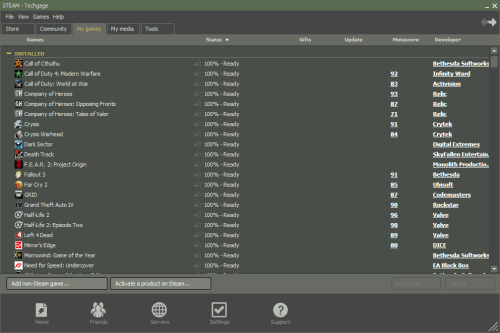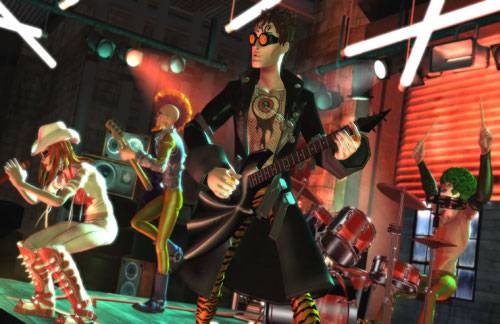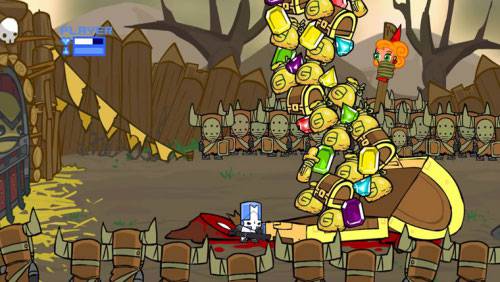- Qualcomm Launches Snapdragon 4 Gen 2 Mobile Platform
- AMD Launches Ryzen PRO 7000 Series Mobile & Desktop Platform
- Intel Launches Sleek Single-Slot Arc Pro A60 Workstation Graphics Card
- NVIDIA Announces Latest Ada Lovelace Additions: GeForce RTX 4060 Ti & RTX 4060
- Maxon Redshift With AMD Radeon GPU Rendering Support Now Available
An Open Letter on the State of Video Games

Senior Editor Brett Thomas has been spending a lot of time analyzing the video games industry recently, and come up with an interesting set of findings. In an open letter to the entire sector, he discusses the challenges facing gaming, the quickly changing landscape and some strategies to keep things growing.
Hello, ladies and gentlemen of the gaming industry – fellow gamers, hardware manufacturers, console makers, and software programmers alike:
I’d like to introduce myself to you – My name is Brett, I’m a nearly 30 (far too close for my liking) year old male. I have a house, two dogs, a (soon-to-be) spouse, and a full-time job as an investment manager and tax accountant. I live a busy life, as you can see. And I, dear industry friends, am your real target market.
Why the introductions, you may ask? Because it seems that things are spinning further and further off track. I came to realize this recently when working through a bit of a project I got myself into, and started to take a very close look at the business behind the video game industry. Most of my research focused on two companies that served the industry in very different ways – Electronic Arts and Sony – but the lessons learned resonate through the industry.
First, let’s start with some facts. Anyone who says gaming is either dying or even stagnant is just plain wrong. A read through the PriceWaterhouseCooper Global Entertainment and Media Outlook for 2009 (a great read for those on the business side) shows that video games are actually the largest growing market in the entertainment industry through the economic downturn (expected through 2011), one of only four segments (out of 12!) that are even expected to show revenue growth. Most of this growth is anticipated over digital channels, meaning direct-downloads to either console or PC.
Interestingly, along with the market expanding (gaming is on track to hit a 2007 forecast of $50 billion by 2011), the average age of a gamer is also expanding. It’s now already over the age of 33, and growing each year. Some would say that’s new market growth, but here is where I start to get into the meat of this letter – it’s not new, it’s retained. We gamers didn’t give up our favorite hobbies as we got older, we just ended up with more things to do. A 33-year-old would have been just about at the average starting gamer age (8-10 years-old) when Commodore64, Tandy, Apple 2E and Atari were on the scene.
 Valve’s Steam Digital Distribution System |
What is not growing is the predominantly male-dominated market of 16-24 year old gamers. There’s only so many to go around, and even the increase of wealth in huge countries like India and China have not produced more gamers buying into this sector. It’s a mature, saturated market.
For many of you, I hope a light bulb just turned on. But just to be sure, let me spell out this very interesting, very vital subtext. Your average gamer nowadays does not have time to devote 40 hours to a single blockbuster FPS game. He (or she! Women are quickly catching up on the percentage of gamers) is already over 30, has considerable disposable income, probably has a house, a spouse, maybe a couple of kids and not a lot of time to go shopping at the local Gamestop or EB. He or she likes casual games, social games, and games that provide a large sense of accomplishment in short amounts of time. It is no secret why Madden NFL, Rock Band and World of Warcraft are at the top of the food chain.
To further my point, most of the projected revenue growth that I mentioned earlier is contingent on digital distribution. This requires a valid credit card, which really requires a person over the age of 18 (at least in the US). Oh, and it also requires companies getting their acts together to provide a content web of accessible, downloadable products. This is a good thing for the industry, obviously, and even better when one considers that every major company in gaming has been pushing to get their games out digitally since about 2007.
Or, have they? Two years later, Valve is still the only company with a mainstream PC digital distribution hub containing more than one publisher of any size. Every independent publisher sells its games digitally only from its own website, leaving the nearly 80 million buyers that browse sites like Amazon and Overstock out in the cold. And the console is really no better – Microsoft’s announcement at E3 for the Xbox 360 was seen as practically revolutionary for the industry, as if we’d just been introduced to broadband allowing us to download more than 1GB of information before. Isn’t this the same industry that treats us all as pirates?
 Harmonix’s Rock Band 2 |
Both XBL and PSN offer a robust storefront, but it’s filled with microcontent for disc-based games or games and development houses you and I have never heard of (and likely won’t take a chance on). Oh, and demos – which are fantastic, but half the time they are being offered as premium content and rewards. This seems backwards – I thought the purpose of a demo was to entice me to buy the game. Why on earth should I have to pre-order a game before I can play a demo of it?
Oh, wait – I know. The price of developing a blockbuster, top-title game is already over $20 million dollars. By the next generation of consoles, it will be over $60 million. Approximately half of all projects started (at least in the case of EA) are scrapped after at least half of that has been spent – meaning that for every game that even hits the market, $30 million (soon to be up to $90 million!) is spent. For those publishing independently (EA, THQ, TakeTwo, etc), the $60 per game charged to the end user is really more like only $45 to the retailer, and then another $10 of each unit goes to licensing fees just for the console. On top of that, another $2-5 is spent making the product because each console manufacturer only allows game discs to be manufactured in-house or by a closely-related company. This is all before any other licensing tie-ins for characters, movies, etc. And after three months, prices fall and many publishers even have to buy back excess inventory.
Let me distill this down to salient points – just to not lose money, every game that even hits a box needs to sell a minimum of about 1 million copies within the first 90 days. And with the new consoles already in the works, it’s not unlikely for royalties to go up along with the development costs, as nobody but Nintendo seems to be able to manufacture a console for a profit. To recoup this, the costs of big-title games will go up… and by the time the cost of the console plus the game is taken into account, that 16-24 year old market will be completely priced out. Which means one of two things will happen – a tremendous increase in piracy, or a tremendous decrease in sales.
Ladies and gentlemen of the industry, I present to you that we are at an inflection point. Things are changing, and currently those of you that work for publishers and manufacturers are not keeping up. Maybe it’s because it’s hard to change. Maybe it’s because everyone wants the next blockbuster title. Or maybe it’s because nobody is recognizing the huge market shift.
Gaming at its core is not about the blockbuster titles. Sure, we all want to see a few released each year…but each of these will cater to one or maybe two segments of a very splintered market. For instance, I personally haven’t played an FPS in years that I’ve enjoyed, except for Half-Life 2 and Bioshock. Both of those games are story-driven and broken into sensible bites, and if they were presented in another format than FPS I probably would still have enjoyed them. On the other hand, my friend Richard (who works in the tech industry) doesn’t really get RTS or RPG games. The same is also true for platforms – he doesn’t even own a Nintendo DS, while mine is with me almost all the time.
 The Behemoth’s Castle Crashers (Xbox Live Arcade) |
I strongly encourage all of you in the industry to look hard at the next generation of consoles, PCs and mobile phones and start saying “What if…” about more than just the graphics. What if games were smaller again? What if you could develop them faster and at a lower price point? What if you focused on episodic content and gameplay innovations? What if you could get content delivered right to my doorstep the minute I feel like playing it? What if you could get it so I can take it with me on my iPhone, DS, or PSP Go?
I’d like to close this letter with the future that I propose through these questions. It’s a future where I can power up my console, my desktop PC, my HTPC, or my mobile phone and be presented with options. It’s a future where games take 3-6 months to develop instead of 18-24 months, where development costs are lessened and lead times reduced so much that you can release lots of games to target all of the different distinct splinters of the market. These games will be priced low enough that they hit my impulsive side and encourage me to take a chance on them. They needn’t be casual in nature, but paced so a casual gamer can enjoy them and released episodically to hook me in. If at all possible, they’ll relate my PSP to my PS3 or my DS to my Wii, making me feel value in my purchase of a cohesive unit. And if you’re really slick, they’ll even relate my DS to my PS3 to my PC.
It worked in the 80’s, when the market was such that only adults afforded the systems that could play games. And more recently, it’s worked for Nintendo with the Virtual Console. Want something more modern? It worked wonders on PSN with the release of Wipeout HD, and on Steam with Portal. It’s time to start listening to your market, particularly those of you that are independent publishers. Every one of you is losing more and more money each fiscal year despite skyrocketing revenues. Gaming is growing because gamers are growing up. It’s time to come along for the ride.
Discuss this article in our forums!
Have a comment you wish to make on this article? Recommendations? Criticism? Feel free to head over to our related thread and put your words to our virtual paper! There is no requirement to register in order to respond to these threads, but it sure doesn’t hurt!
Support our efforts! With ad revenue at an all-time low for written websites, we're relying more than ever on reader support to help us continue putting so much effort into this type of content. You can support us by becoming a Patron, or by using our Amazon shopping affiliate links listed through our articles. Thanks for your support!




